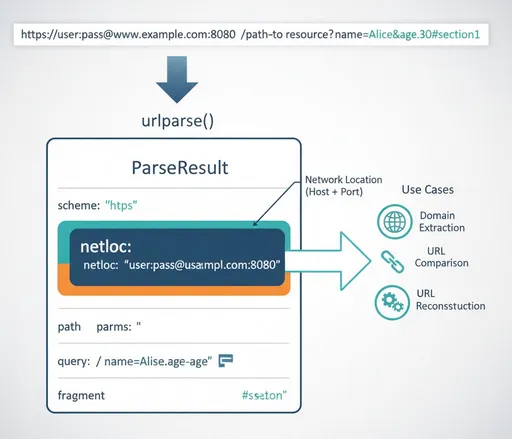In the internet age, URL (Uniform Resource Locator) is the fundamental address indicating the location of information. Various fields such as web development and data analysis often require handling URLs, and there are times when it is necessary to extract only specific parts of the URL (e.g., domain, path, query parameters) instead of the entire URL. In such cases, Python's urllib.parse module provides the powerful urlparse() function as a tool.
In this article, we will explore the basic usage of the urlparse() function, the meaning and use cases of the commonly used .netloc attribute, as well as various properties of the ParseResult object returned by urlparse().
1. What is urlparse()?
urlparse() is a function that decomposes a URL string into several components according to the RFC 1738 (Universal Resource Locators in WWW) and RFC 3986 (Uniform Resource Identifier (URI): Generic Syntax) standards. Each of these decomposed components is returned in a special object named ParseResult.
Basic Usage
The urlparse() function is imported from the urllib.parse module.
from urllib.parse import urlparse
url = 'https://user:pass@www.example.com:8080/path/to/resource?name=Alice&age=30#section1'
parsed_url = urlparse(url)
print(parsed_url)
# Output: ParseResult(scheme='https', netloc='user:pass@www.example.com:8080', path='/path/to/resource', params='', query='name=Alice&age=30', fragment='section1')
The parsed_url object can be accessed by index like a tuple, as well as through named attributes, which is much more readable.
2. Key Attributes of ParseResult Object
The ParseResult object returned by urlparse() has the following attributes.
scheme
-
Meaning: Represents the protocol part of the URL. (
http,https,ftp,mailto, etc.) -
Example:
'https'
netloc (Network Location)
-
Meaning: The part that includes the hostname (domain), port number, and optionally, user authentication information (
user:pass@). -
Example:
'user:pass@www.example.com:8080' -
Use: Useful for extracting only the domain of a specific web service or checking the port number for network connections. We will cover this in more detail later.
path
-
Meaning: Represents the specific resource path within the web server.
-
Example:
'/path/to/resource'
params (Path Parameters)
-
Meaning: Path parameters that are separated by a semicolon (
;). Defined by RFC, but rarely used in modern web applications; mainly queries are used instead. -
Example:
';sessionid=xyz'(rarely used)
query
-
Meaning: The query string that comes after the question mark (
?). It is used to pass data to the server in the form of key-value pairs. -
Example:
'name=Alice&age=30' -
Use: When used with the
urllib.parse.parse_qs()function, it can be easily parsed into a dictionary format.
from urllib.parse import parse_qs
query_params = parse_qs(parsed_url.query)
print(query_params)
# Output: {'name': ['Alice'], 'age': ['30']}
fragment
-
Meaning: The fragment identifier that comes after the hash (
#). It is mainly used to navigate to a specific section within a web page, and it is not sent to the server but handled only by the browser. -
Example:
'section1'
3. In-depth Analysis of the .netloc Attribute
The .netloc is particularly important among the results of urlparse(). netloc is short for Network Location and contains essential information related to the web server's address in the URL.
netloc Components
The netloc can consist of the following elements.
-
User Information: It can include the username and password in the format
user:password@. For security reasons, this is rarely used in common web URLs but can be seen in other protocols like FTP. -
Host: The domain name (
www.example.com) or an IP address (192.168.1.1). -
Port: The port number that comes after a
:. When the default ports, such as 80 for HTTP and 443 for HTTPS, are used, the port number may be omitted innetloc.
Example:
| URL | netloc Result | Description |
|---|---|---|
https://www.example.com |
www.example.com |
Includes only the domain (default port 443 for HTTPS is omitted) |
http://myhost:8000/app |
myhost:8000 |
Includes host and port |
ftp://user:pass@ftp.example.org |
user:pass@ftp.example.org |
Includes user information and host |
Why and How to Use .netloc
-
Domain Extraction and Validation:
-
By checking which website a request has come from, you can apply security policies or easily extract the domain part through
netlocwhen only specific domains are allowed. -
Using the
parsed_url.hostnameattribute, you can obtain only the hostname without the port number fromnetloc.
-
url = 'https://www.example.com:8080/path'
parsed = urlparse(url)
print(parsed.netloc) # 'www.example.com:8080'
print(parsed.hostname) # 'www.example.com'
print(parsed.port) # 8080 (int)
-
URL Reconstruction or Modification:
-
The
ParseResultobject decomposed byurlparse()is immutable, but you can create a newParseResultwith specific attributes changed using the.replace()method. This modified object can be easily reconstructed into a new URL by passing it back to theurlunparse()function. -
For instance, when implementing a redirect to a specific domain, you can create a new URL by changing only the
netloc.
-
from urllib.parse import urlparse, urlunparse
original_url = 'https://old.example.com/data'
parsed_original = urlparse(original_url)
# Create a new URL by changing only the domain
new_netloc = 'new.example.com'
modified_parsed = parsed_original._replace(netloc=new_netloc)
new_url = urlunparse(modified_parsed)
print(new_url) # Output: https://new.example.com/data
-
URL Identity Comparison (Based on Domain/Port):
- When you need to check if two URLs point to the same server, comparing the
netlocattribute is useful.
- When you need to check if two URLs point to the same server, comparing the
url1 = 'https://api.myapp.com/v1/users'
url2 = 'https://api.myapp.com:443/v2/products' # 443 is the default port for HTTPS
url3 = 'https://oldapi.myapp.com/v1/users'
parsed1 = urlparse(url1)
parsed2 = urlparse(url2)
parsed3 = urlparse(url3)
print(parsed1.netloc == parsed2.netloc) # True (default port can be omitted and treated as identical)
print(parsed1.hostname == parsed2.hostname) # True
print(parsed1.netloc == parsed3.netloc) # False
4. Differences Between urlparse() and urlsplit()
The urllib.parse module also includes the urlsplit() function, which is very similar to urlparse(). The main difference between the two functions is how they handle the params attribute.
-
urlparse(): Separately extracts theparamsattribute. -
urlsplit(): Includes theparamsattribute within thepathwhen returning. Instead of returning aParseResult, it returns aSplitResultobject, which does not have theparamsattribute.
In modern web development, since params are rarely used, it is often acceptable to use urlsplit(). However, urlparse() provides a more general and complete separation.
Conclusion: An Essential Tool for URL Analysis
Python's urlparse() function is a powerful tool that allows you to systematically decompose complex URL strings and extract only the necessary parts. In particular, the .netloc attribute provides vital host and port information, making it extremely useful for domain-based logic processing or URL reconstruction.
For all Python developers dealing with URLs, including web scraping, API request handling, and security validation, urlparse() is fundamental knowledge that you must acquire. Through this function, you will be able to control and utilize URL data more effectively.


There are no comments.